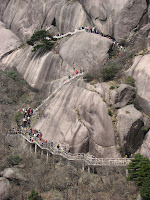
We took a train from Nanjing to Kaifeng in
Henan province. It is not a place that is on
every one's 'must see in China list' but it looked like a good place to stop on our way to Xian and the Terracotta Warriors. The train was full as we were only able to get a hard seat and there were lots of people standing in the aisles. There were several TV screens in the train showing a reality show of people making fools of themselves in public and a Chinese film where they fly through the air, drink potions that give them super powers and then they have loads of
Kung Fu fights. This kept everyone occupied and helped the time pass quickly and the uniformed railway sales people had to compete for an audience and customers.
We chose a hotel from the Lonely Planet guide book and arrived there at about 8pm to a rain soaked city. The hotel was enormous and there were lots of business men staggering about after their evening of drinks. It had a plaque saying it was a 2 star hotel. It must have been wonderful when it was first built but it is now adequate but neglected.
There were only a few stalls selling food in the Muslim night market street outside the hotel because of the cold wet weather so we headed for a
Mc Donald's restaurant for some fast food -most seem to be open for 24 hours. We were ambushed by a local young man who wanted to practise his English and tell us about his dreams to go to the US to study and play basketball. His attempts to communicate our order to the staff ended up confusing everyone - he was keen to impress his mother with his skills as I guess she will have to pay for his trip.
In the morning we were greeted by another local who introduced himself as Jason (
Xu Shi Jie) and he showed us his notebooks full of clients he had guided around the city- 408 of them- over the last 4 years. He told us he is a Christian and has been learning English for 28 years and is self-taught. He usually works as a rickshaw driver but loves to speak English and guide any tourists if they are about.
We became clients number 409!

Kaifeng is south of the Yellow River and after centuries of flooding the old Northern Song city is buried 8or 9 metres beneath. Between 1194 and 1938 the city was flooded 368 times-an average of once every two years!
The city is surrounded by fertile fields of crops from the silt.
Kaifeng was the first city in China where Jewish people settled after arriving from India along the Silk Road. There is a small Christian community and a much larger Muslim community.
While strolling down a local street we passed Jason's local barber so went in to say hello. John decided to get his hair cut and joined the queue for 1
RMB- about 20c NZ - she had just increased her prices by 50% but gave it to him at the old price!

We had a fantastic day with Jason. We visited the
Yanqing Temple which was built to commemorate Wang
Zhe the founder of the True unity Sect of Taoism. There were many women sitting inside the domed building chatting.

The carvings at the
Shanshangan Guild hall were fantastic. The grapes on the beams look so real and the beams were carved from a single log. Jason was able to tell us the significance of some of the carvings. Many of them are symbols for wealth, prosperity, happiness and
generativity (the
pomegranate featured to symbolise more sons, grandsons and the
continuance of the family line). The hall was built by merchants from different provinces and was very interesting.

We caught a bus to a park to watch the locals at play. On the bus some of the old people (much older than us) wanted to show their good manners by giving up their seats for us. Of course we insisted that they sat down and so this banter would go on and on and the seat would remain empty until there were enough seats for us all to sit!
At the park which was full of mainly retired folk we saw groups practising their
diablo tossing skills,

gambling at cards and
mah jong,

singing opera,
and whipping their tops into action.

There was also a free haircutting class as trainees got their skills up.

A lot of the people in the park had seen Jason on TV and in an article in a newspaper about his activities with tourists-from 3 years ago. They couldn't believe that a rickshaw driver could speak English.
We chatted to some of them about NZ too and they knew
Helen Clark (our PM) was in China. They also knew that we had lots of sheep and were
convinced we had sheep milk as well!
Not much money has been spent on modernizing Kaifeng and with the old city buried the planners are not allowed to build tall buildings that need deep foundations for fear of damaging the underground city.



























































